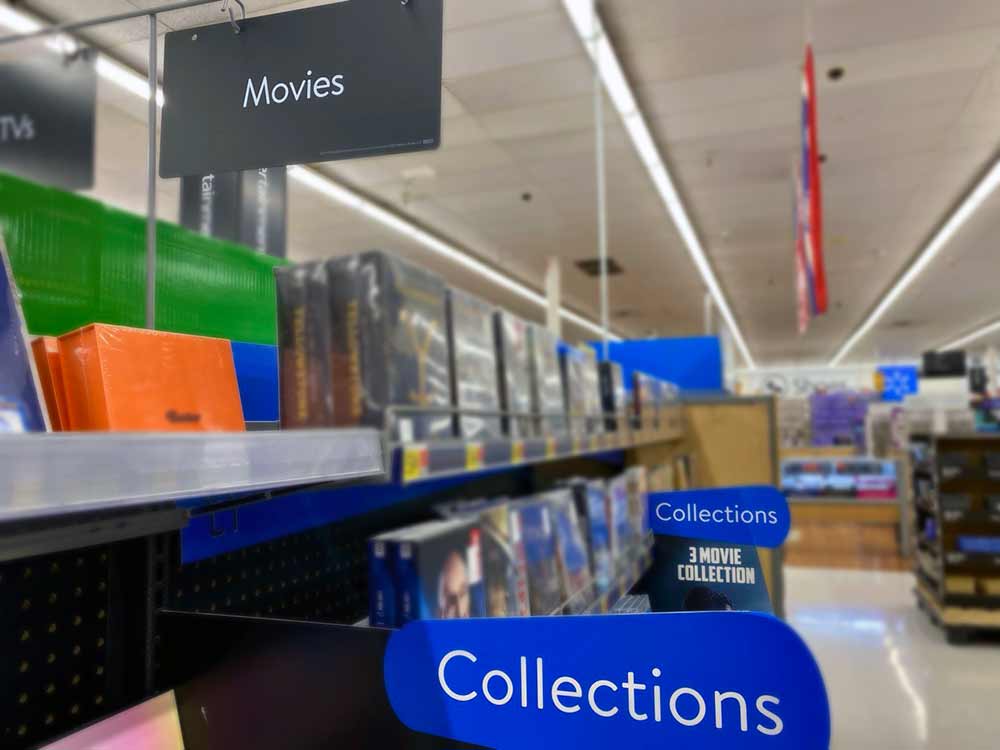What happened to the Blu-ray? The Once King of High-Definition Entertainment
Once the undisputed champion of high-definition home entertainment, Blu-ray has experienced a market decline in recent decades, based on statistics. While its mainstream dominance may have somewhat faded, the format is far from obsolete.
This article explores the evolving landscape of physical media, examining how the shift to streaming has created a dedicated niche market for Blu-ray discs.
When was Blu-ray at its peak?
Blu-ray discs revolutionized physical media with their high-definition content and superior audio quality. It’s hard to imagine a time when streaming services didn’t exist, and the only way to enjoy a movie at home was through TV broadcasts or physical media like VHS tapes or discs.
There was something about going to the store or local video rental shop to get the latest movies. We now take for granted how online platforms have made entertainment so convenient and accessible, often forgetting the era of owning physical media.
Blu-ray Hits the Scene
The Blu-ray technology reached its peak popularity in the late 2000s and early 2010s. During this time, Blu-ray discs became the preferred choice for high-definition viewing, offering superior video and audio quality compared to traditional DVDs. The availability of a wide range of movies and TV shows in Blu-ray format also contributed to its peak popularity in home theaters.
You could easily rent DVD and Blu-ray movies from Blockbuster up until it closed in 2014. Surprisingly, you can still rent DVD and Blu-ray movies from kiosks like Redbox at over 40,000 locations, such as Walgreens and Walmart. While movie kiosks are becoming less common, they still provide a great way to access physical media.
As mainstream viewers embrace the convenience of digital streaming, the consumer demand for physical media like Blu-ray discs has declined. The move toward digital streaming has resulted in a diminished selection of Blu-ray movie titles available in brick-and-mortar retail stores.
Understanding this transition from physical media to digital streaming is crucial in grasping the evolution of entertainment consumption habits. While Blu-ray technology may have had its heyday, its legacy continues to shape how we consume and interact with media content in an increasingly digital world.
The Niche Resurgence of Blu-ray
While Blu-ray has not seen the same broad-market revival as vinyl records, it is carving out a significant niche among a dedicated community of collectors and cinephiles. The comeback of vinyl, which began unexpectedly in the mid-2000s despite the rise of digital music, serves as a point of comparison for the current trend.
There’s a unique satisfaction that comes from owning physical media for music or videos. Unlike physical copies, digital media is often just licensed and can be removed at any time.
Physical media is experiencing interest, thanks to a dedicated audience. This is particularly true for high-quality video formats like Blu-ray. The market for these discs is increasingly driven by boutique labels that specialize in premium, special-edition releases. These labels cater to enthusiasts who prioritize superior picture and sound quality over the compressed formats often found on streaming services. However, this collector-driven demand exists against the backdrop of a larger trend as streaming services continue to grow in the consumer market.
How did the Impact of Streaming Services Decline Blu-ray’s Dominance?

Image by: Freepik.com
The rise of digital streaming platforms such as Netflix, Hulu, and Amazon Prime Video has impacted the popularity of physical media like Blu-ray. With the convenience and accessibility offered by streaming services, traditional formats like Blu-ray are experiencing a decline in demand.
In 2007, Netflix made history by introducing its groundbreaking online streaming service, forever changing how we consume entertainment. This allowed viewers to access a vast library of content at their fingertips, anytime and anywhere.
Samsung took a decisive step by ceasing the production of its Blu-ray players in 2019, causing a scarcity of new players in the market as time progressed. With the trend shifting towards digital formats, it has become a rarity to find prebuilt desktop PCs or laptops equipped with optical drives nowadays. Consequently, if you possess a cherished collection of Blu-ray discs that you wish to enjoy, your avenues for playing them have undeniably narrowed.
As consumers increasingly opt for the ease of streaming content online, the appeal of purchasing physical copies, like Blu-rays, has dwindled. The vast libraries and on-demand nature of streaming platforms provide instant gratification without the need for physical storage or equipment.
This shift in consumer behavior towards digital streaming versus Blu-ray signifies a broader trend in media consumption preferences. As technology advances and internet speeds improve, it’s evident that streaming services have reshaped how we access and enjoy entertainment content.
Netflix Mails Final DVD Envelope, Opening the Door to Streaming
In September 2023, Netflix mailed out its final red envelope, signaling the end of an era for its once-iconic physical media service and reshaping how we consume entertainment. The company’s shift from mailing DVDs to prioritizing digital content reflects changing consumer preferences. This move has also proven to be a cost-saving measure, leading to higher profits. This reality defines today’s consumer landscape.

A man is searching through Blu-ray and DVD movies in a retail store. Image by: Freepik.com
Best Buy and Target to Scale Back the Sale of DVDs and Blu-ray
Starting in 2024, Best Buy, a renowned retailer in the realm of consumer electronics, has taken a strategic decision to discontinue the sale of DVDs and Blu-ray discs both through its physical stores and online platforms.
Blu-ray now joins the list of phased-out physical media formats in stores, including CD, DVD, Laserdisc, Betamax, and VHS.
Target has announced that, effective in 2025, it will scale back its in-store inventory of Blu-ray and DVD movies to a limited selection of new releases. A more extensive catalog will remain available on its website.
This bold move marks a significant shift in their product offerings, aligning with the evolving digital landscape and changing consumer preferences towards streaming services and digital content consumption.
Is Blu-ray still available in stores?

Small Blu-ray movie selection sold at Walmart in 2024.
Despite the rise of streaming services and digital downloads, Blu-ray discs are still available in selected retail stores such as Walmart. Many retail stores like Best Buy and Target have shifted to providing Blu-ray discs only through their online store websites.
The in-store selection at many retailers is often frustratingly limited, with the majority of the inventory focused on new releases. This sparse selection can be a significant drawback for customers seeking a more diverse and comprehensive shopping experience.
When stores prioritize stocking the latest titles and products, they neglect to maintain a robust inventory of older, yet still highly desirable items. This is mainly due to the lack of demand for those items in the store’s sales.
While the format may not have the same level of mainstream popularity as it did during its heyday, Blu-ray continues to cater to a dedicated consumer base that values high-quality physical media.
Lessons from the Short Life and Failures of Blu-ray
The rise and fall of Blu-ray technology serve as a powerful cautionary tale for the tech industry, illuminating valuable lessons that can guide future innovation and market strategies. Despite its relatively brief lifespan and eventual decline, Blu-ray left an indelible mark on the way we engage with media content.
Blu-ray was launched in 2006, offering higher quality than DVDs. In 2007, Netflix launched its initial online streaming service, providing more flexibility to consumers. Unfortunately, it was just bad timing for Blu-ray.
The versatility of the Blu-ray player was not marketed as effectively as it could have been. Many were unaware that a Blu-ray player could play CDs and DVDs. This common misconception deterred many from transitioning to Blu-ray, as they were hesitant to replace the DVDs they had collected over the years.
The Blu-ray was a more expensive alternative to the DVD. Consumers didn’t always leap to transition to Blu-ray due to the price factor or to replace their DVD collections.
Conclusion
Blu-ray technology holds a significant place in the history of the digital world, providing consumers with unparalleled visual and audio quality during its time. Looking ahead to the future, its legacy continues to evolve through advancements in storage capacity and data transfer speeds.
The prospects of Blu-ray technology remain promising, especially with the rise of 4K Ultra HD and even 8K content. Its ability to deliver high-definition entertainment experiences will likely endure as consumer demand for top-notch viewing experiences persists.
While the format’s mainstream reign has given way to the convenience of streaming, it has found a new, more passionate life. It signifies a transition from a mass-market commodity to a cherished collector’s item.
The shift to a collector-driven online market means that the focus is on quality over quantity. Independent companies are leading the charge for premium home media. This new landscape offers a sense of permanence and tangible ownership in an increasingly digital world, ensuring that the films we love will always be available to us in their finest form.
So, as we move forward, let’s embrace this new era of physical media. Let’s celebrate the vibrant community of collectors, the dedicated labels, and the superior quality that Blu-ray offers. The era of casual ownership may be over, but the age of the true film enthusiast has just begun.












